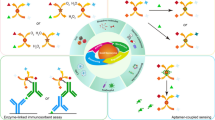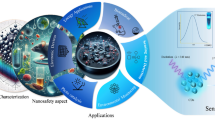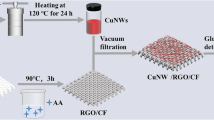Abstract
A new nano-structured platform for fluorescent analysis using PQQ-dependent glucose dehydrogenase (PQQ-GDH) was developed, particularly using a smartphone for transduction and quantification of optical signals. The PQQ-GDH enzyme was immobilized on SiO2 nanoparticles deposited on glass microfiber filter paper, providing a high load of the biocatalytic enzyme. The platform was tested and optimized for glucose determination using a wild type of the PQQ-GDH enzyme. The analysis was based on the fluorescence generated by the reduced form of phenazine methosulfate produced stoichiometrically to the glucose concentration. The fluorescent signals were generated at separate analytical spots on the paper support under wavelength (365 nm) UV excitation. The images of the analytical spots, dependent on the glucose concentration, were obtained using a photo camera of a standard smartphone. Then, the images were processed and quantified using software installed in a smartphone. The developed biocatalytic platform is the first step to assembling a large variety of biosensors using the same platform functionalized with artificial allosteric chimeric PQQ-dependent glucose dehydrogenase activated with different analytes. The future combination of the artificial enzymes, the presently developed analytical platform, and signal processing with a smartphone will lead to novel point-of-care and end-user biosensors applicable to virtually all possible analytes.
Graphical abstract




Similar content being viewed by others
References
Venn RF (ed) (2008) Principles and practice of bioanalysis. CRC Press, Boca Raton
Scheller FW, Hintsche R, Pfeiffer D, Schubert F, Riedel K, Kindervater R (1991) Biosensors: Fundamentals, applications and trends. Sens Actuat B 4:197–206
Hnasko R (2015) ELISA - Methods and protocols. Springer Science, New York
Huang X, Xu D, Chen J, Liu J, Li Y, Song J, Ma X, Guo J (2018) Smartphone-based analytical biosensors. Analyst 143:5339–5351
Kanchi S, Sabela MI, Mdluli PS, Inamuddin, Bisetty K (2017) Smartphone based bioanalytical and diagnosis applications: a review. Biosens Bioelectron 102:136–149
McCracken KE, Yoon J-Y (2016) Recent approaches for optical smartphone sensing in resource-limited settings: a brief review. Anal Methods 8:6591–6601
Rateni G, Dario P, Cavallo F (2017) Smartphone-based food diagnostic technologies: a review. Sensors 17:art. No. 1453
Roda A, Michelini E, Zangheri M, Di Fusco M, Calabria D, Simoni P (2016) Smartphone-based biosensors: a critical review and perspectives. Trends Anal Chem 79:317–325
Xu X, Akay A, Wei H, Wang S, Pingguan-Murphy B, Erlandsson B-E, Li X, Lee W, Hu J, Wang L (2015) Advances in smartphone-based point-of-care diagnostics. Proc IEEE 103:236–247
Zhang D, Liu Q (2016) Biosensors and bioelectronics on smartphone for portable biochemical detection. Biosens Bioelectron 75:273–284
Jia Y, Sun H, Li X, Sun DK, Hu T, Xiang N, Ni ZH (2018) Paper-based graphene oxide biosensor coupled with smartphone for the quantification of glucose in oral fluid. Biomed Microdevices 20:art. No. 89
Soni A, Jha SK (2017) Smartphone based non-invasive salivary glucose biosensor. Anal Chim Acta 996:54–63
Elsherif M, Hassan MU, Yetisen AK, Butt H (2019) Hydrogel optical fibers for continuous glucose monitoring. Biosens Bioelectron 137:5–32
Lin YR, Hung CC, Chiu HY, Chang BH, Li BR, Cheng SJ, Yang JW, Lin SF, Chen GY (2018) Noninvasive glucose monitoring with a contact lens and smartphone. Sensors (Basel) 18:3208
Choi J, Bandodkar AJ, Reeder JT, Ray TR, Turnquist A, Kim SB, Nyberg N, Hourlier-Fargette A, Model JB, Aranyosi AJ, Xu S, Ghaffari R, Rogers JA (2019) Soft, skin-integrated multifunctional microfluidic systems for accurate colorimetric analysis of sweat biomarkers and temperature. ACS Sensors 4:379–388
Erenas MM, Carrillo-Aguilera B, Cantrell K, Gonzalez-Chocano S, Vargas-Sansalvador IM, Orbe-Payá I, Capitan-Vallvey LF (2019) Real time monitoring of glucose in whole blood by smartphone. Biosens Bioelectron 136:47–52
Vaquer A, Barón E, de la Rica R (2021) Detection of low glucose levels in sweat with colorimetric wearable biosensors. Analyst 146:3273–3279
Guo L, Chen S, Yu YL, Wang JH (2021) A Smartphone optical device for point-of-care testing of glucose and cholesterol using Ag NPs/UiO-66-NH2-based ratiometric fluorescent probe. Anal Chem 93:16240–16247
Alizadeh N, Salimi A, Hallaj R (2019) A strategy for visual optical determination of glucose based on a smartphone device using fluorescent boron-doped carbon nanoparticles as a light-up probe. Mikrochim Acta 187:14
Sun K, Yang Y, Zhou H, Yin S, Qin W, Yu J, Chiu DT, Yuan Z, Zhang X, Wu C (2018) Ultrabright polymer-dot transducer enabled wireless glucose monitoring via a smartphone. ACS Nano 12:5176–5184
Deng M, Song G, Zhong K, Wang Z, Xia X, Tian Y (2022) Wearable fluorescent contact lenses for monitoring glucose via a smartphone. Sens Actuators B Chem 352:131067
Song C, Yang Y, Tu X, Chen Z, Gong J, Lin C (2021) A smartphone-based fluorescence microscope with hydraulically driven optofluidic lens for quantification of glucose. IEEE Sens J 21:1229–1235
Guo Z, Smutok O, Johnston WA, Ayva CE, Walden P, McWhinney B, Ungerer JPJ, Melman A, Katz E, Alexandrov K (2021) Circular permutated PQQ-glucose dehydrogenase as an ultrasensitive electrochemical biosensor. Angew Chem Int Ed 61:e202109005
Bollella P, Edwardraja S, Guo Z, Whitfield J, Melman A, Alexandrov K, Katz E (2021) Connecting artificial proteolytic and electrochemical signaling systems with caged messenger peptides. ACS Sensors 6:3596–3603
Guo Z, Smutok O, Johnston WA, Walden P, Ungerer JPJ, Peat TS, Newman J, Parker J, Nebl T, Melman A, Suderman RJ, Katz E, Alexandrov K, K, (2021) Design of a methotrexate-controlled chemical dimerization system and its use in bio-electronic devices. Nature Commun 12:article No. 7137
Guo Z, Johnston WA, Whitfield J, Walden P, Cui Z, Wijker E, SelvakumarEdwardraja S, Lantadilla IR, Ely F, Vickers C, Ungerer JPJ, Alexandrov K (2019) Generalizable protein biosensors based on synthetic switch modules. J Am Chem Soc 141(20):8128–8135
Oubrie A, Rozeboom HJ, Kalk KH, Olsthoorn AJ, Duine JA, Dijkstra BW (1999) Structure and mechanism of soluble quinoprotein glucose dehydrogenase. EMBO J 18:5187–5194
Stockert JC, Carou MC, Casas AG, GarcíaVior MC, EzquerraRiega SD, Blanco MM, Espada J, Blázquez-Castro A, Horobin RW, Lombardo DM (2020) Fluorescent redox-dependent labeling of lipid droplets in cultured cells by reduced phenazine methosulfate. Heliyon 6:art. No. e04182
Willner I, Katz E (2000) Integration of layered redox-proteins and conductive supports for bioelectronic applications. Angew Chem Int Ed 39:1180–1218
Wells PK, Smutok O, Melman A, Katz E (2021) Switchable biocatalytic reactions controlled by interfacial pH changes produced by orthogonal biocatalytic processes. ACS Appl Mater Interfaces 13:33830–33839
Padayatty SJ, Levine M (2016) Vitamin C physiology: the known and the unknown and Goldilocks. Oral Dis 22:463–493
Costello LC, Franklin RB (2016) Plasma citrate homeostasis: how it is regulated; and its physiological and clinical implications. An important, but neglected, relationship in medicine. HSOA J Hum Endocrinol 1:art. No. 005
Woerle HJ (2004) Glucose physiology, normal. In: Huhtaniemi I (ed) Encyclopedia of Endocrine Diseases. Academic Press, Cambridge, pp 263–270
Funding
This work was supported in part by the Human Frontier Science Program, project grant RGP0002/2018 to OS and EK, and by the US Department of Defense award W81XWH2010708 to EK. This paper is dedicated to the memory of Prof. Artem Melman (deceased in 2021) who was one of the leading scientists working on this project, as well as on many other research projects.
Author information
Authors and Affiliations
Corresponding authors
Ethics declarations
Conflict of interest
The authors declare no competing interests.
Additional information
This paper is dedicated to the memory of Artem Melman.
Publisher's note
Springer Nature remains neutral with regard to jurisdictional claims in published maps and institutional affiliations.
Supplementary Information
Below is the link to the electronic supplementary material.
Rights and permissions
Springer Nature or its licensor holds exclusive rights to this article under a publishing agreement with the author(s) or other rightsholder(s); author self-archiving of the accepted manuscript version of this article is solely governed by the terms of such publishing agreement and applicable law.
About this article
Cite this article
Wells, P.K., Melman, A., Katz, E. et al. Fluorescent sensor based on pyrroloquinoline quinone (PQQ)-glucose dehydrogenase for glucose detection with smartphone-adapted signal analysis. Microchim Acta 189, 371 (2022). https://doi.org/10.1007/s00604-022-05466-4
Received:
Accepted:
Published:
DOI: https://doi.org/10.1007/s00604-022-05466-4




